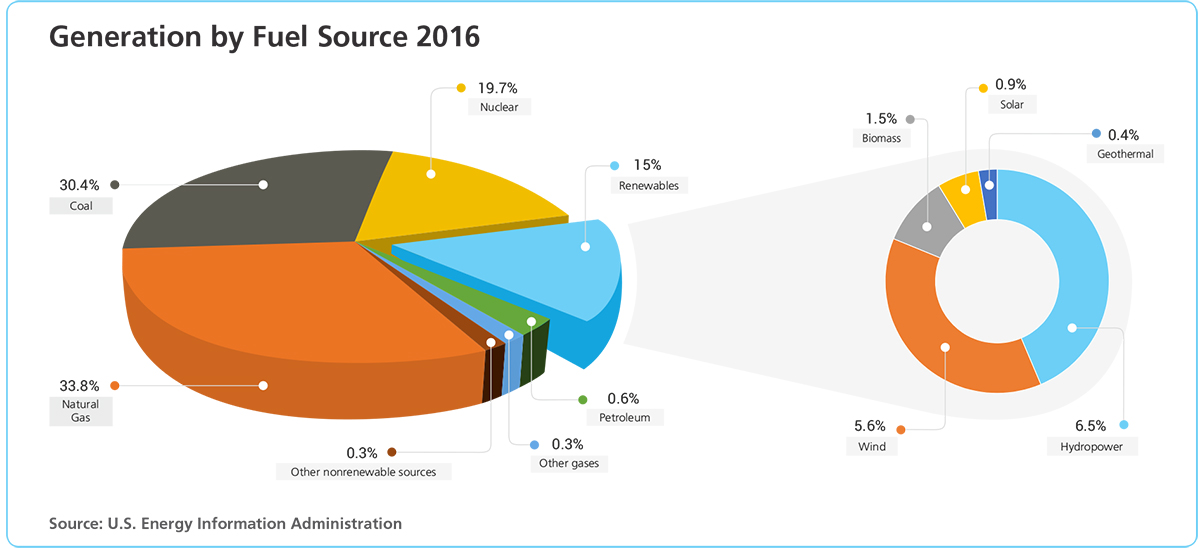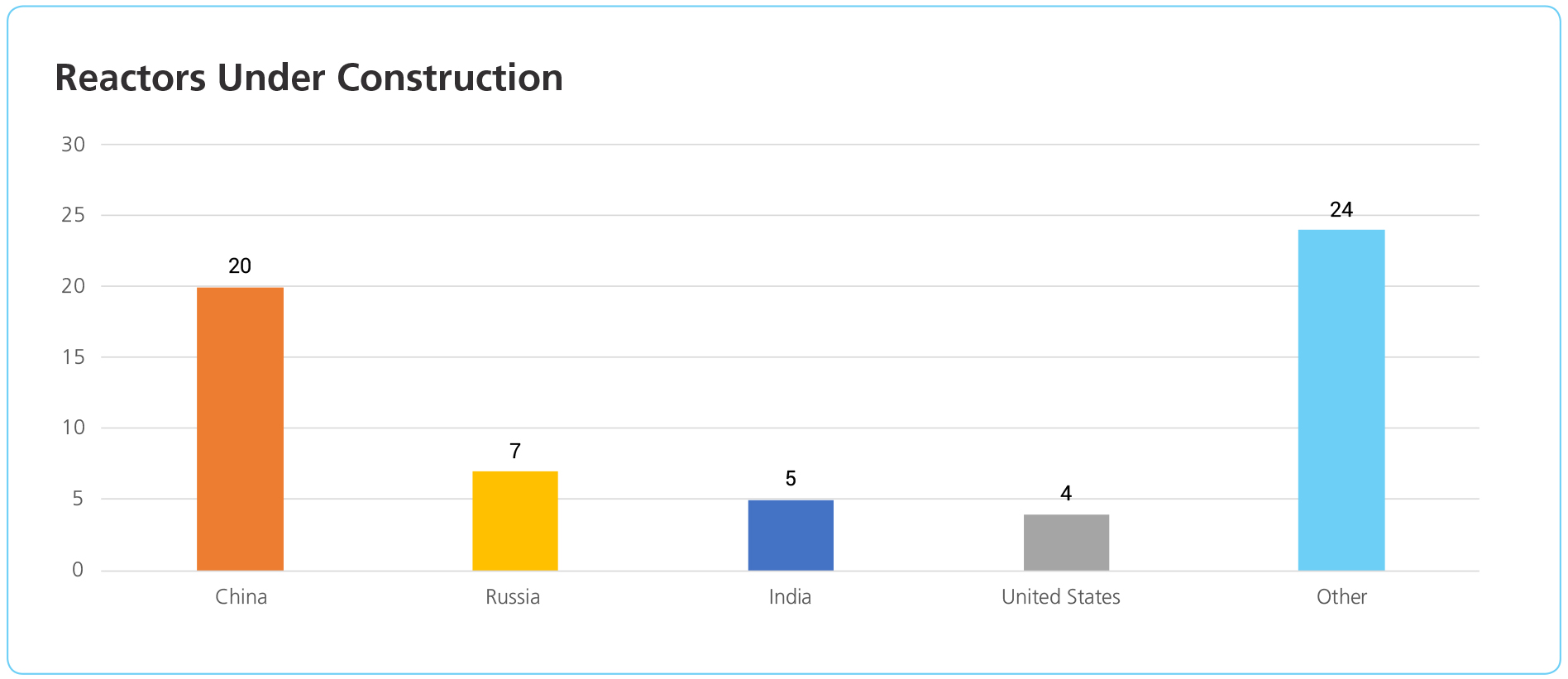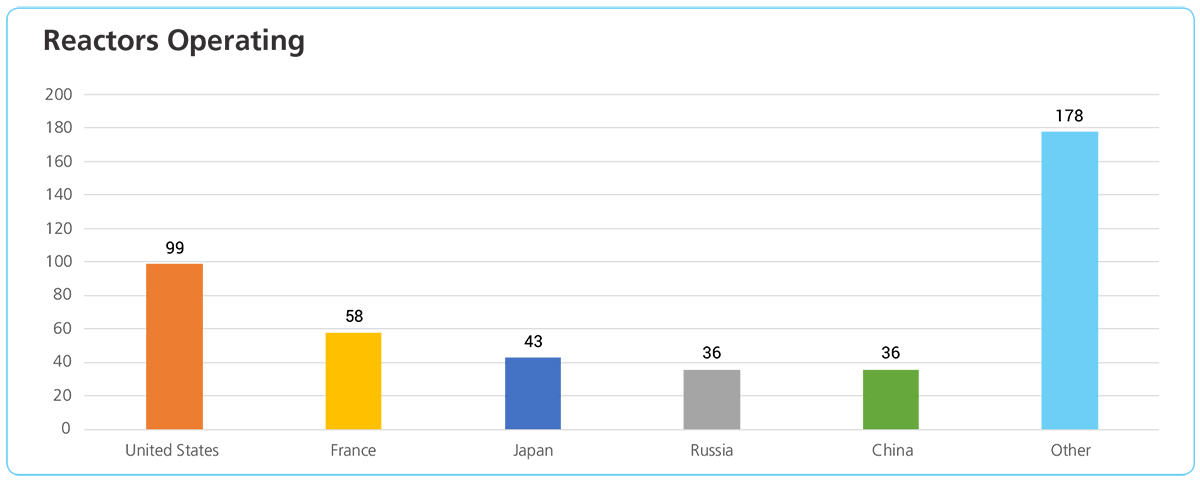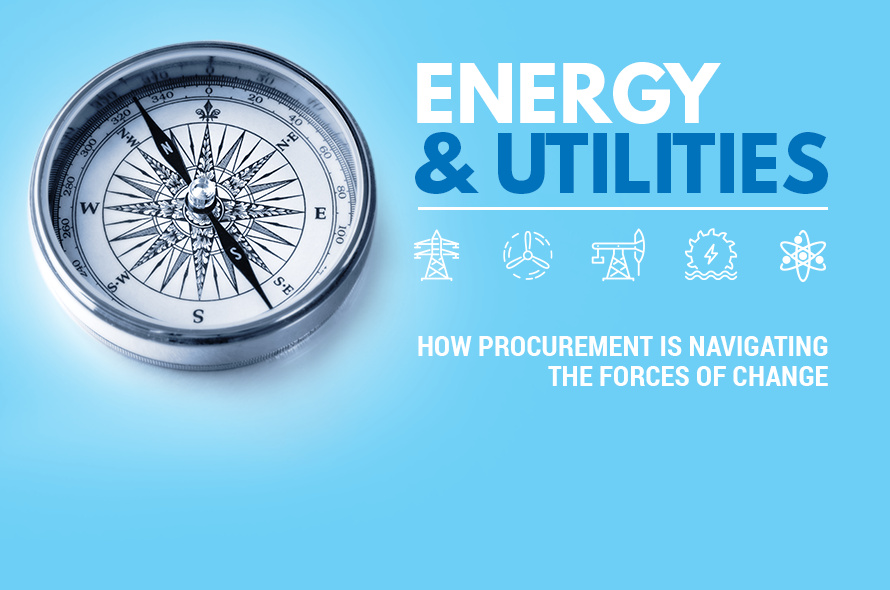Introduction
The new presidential administration in the United States has put energy policy squarely in the spotlight as a central ingredient of its growth strategy. As the executive branch proceeds with a large-scale rollback of Obama-era climate actions, procurement professionals within the energy and utilities sector are trying to interpret the impact of these forces of change on the strategies and processes that they employ on a day-to-day basis.
This report assesses the evolving U.S. political and regulatory environment and then evaluates the changing energy landscape. It highlights the impacts of nationalism vs. globalism, border adjustment taxes, potentially reduced regulations and lower corporate taxes on this segment. In addition, this report includes discussion of declining nuclear ambitions, growth of renewables, and the deepening natural gas glut. The goal is to provide insight to category managers looking to navigate their procurement function and continue to deliver value in a time of significant uncertainty.
Procurement organizations in many utilities have significantly advanced their capabilities in the past decade, introducing concepts of strategic sourcing and improving management of spend, suppliers and contracts. The increasing adoption of procurement-specific technology has helped these organizations gain complete and manageable information, adding both speed and accuracy to the process. These advances have occurred within a period of relative stability and consistency.
Now, expectations have changed — procurement organizations need to develop management skills focused on agility, flexibility, data and automation. Procurement professionals are expected to be “knowledge workers,” looking way beyond the linear buyer-seller relationship and reaching far into the supply chain and the markets in which suppliers operate. Procurement directors have been waiting for a time when they could become part of the strategic conversation in the executive suite. We can declare that that time has arrived.
While it is important for procurement to align with management’s priorities, it is also important to build capabilities to have the complete enterprise-wide spend under management. This would help procurement retain its status as a strategic partner and minimize the chances of its role reverting to merely tactical.
Forces of Change: Political, Economic And Regulatory
With the new presidential administration, the United States currently finds itself largely divided into two camps: one that views the anticipated changes as long awaited, and another for whom this prospect of change inspires fear and dread. This report seeks to remove these emotions from the debate and focus on the current outlook for the electric utility segment along with the impact of anticipated changes on this industry’s procurement strategies and capabilities.
Many in the broader market are optimistic about the U.S. economy based on pro-business policies and promised reductions in corporate and individual tax rates and regulations. But a smooth ride to this goal is unlikely due to predicted market volatility driven by potential cross-border trade restrictions and border adjustment taxes on foreign goods imported for sale, in addition to the headlines and tweets being generated in Washington.
As the economy strengthens and interest rates start to rise, the dollar will grow stronger. In this scenario, many U.S. companies serving overseas customers will be negatively impacted, but the utilities sector will be largely insulated because its business is conducted primarily in the domestic market. What does impact utilities, however, are the higher interest rates, customarily with large asset-based businesses and high debt models. Finally, the likely potential of reduced corporate income taxes will benefit utilities, which are a relatively high income tax-paying sector. In general, the economic forces in play from a policy standpoint are expected to be a “wash” for utilities.
The Trump administration from the start has made regulation reduction and simplification a central part of its growth agenda. In March 2017, the president ordered the EPA to withdraw the Clean Power Rule, which was part of the climate initiative issued by President Obama in 2015. This rule imposed the first-ever federal limits on carbon emission from power plants (without a congressional vote). Combining the reversal of this rule with a more pro-business stance on the coal and mining industry, it is expected that coal will maintain a 30 percent level in the fuel mix for U.S. electric power generation over the coming five- to 10-year period.
The most startling events of 2016 for most business professionals were the British vote to leave the European Union in June, and the election of U.S. President Trump in November. Central to both campaigns is a simple principle — the nation-state takes priority above globalism. As the Wall Street Journal has noted, the new nationalist surge has “startled” establishment parties that never viewed globalism as an ideology. But it is, and its widespread rejection will be shaping trade and sourcing decisions for the near future.
Procurement professionals need to be aware of these issues as they source for products in both global and domestic markets. It is imperative for procurement leaders in the United States to conduct a comprehensive review of strategic supplier relationships and assess the potential risks associated with geopolitical shifts. Procurement teams must develop supply market strategies that recognize potential implications in terms of financial cost, public opinion, and continuity of supply. The critical nature of this process should become evident to U.S. procurement leaders when one considers that seven of the top ten solar panel manufacturers are headquartered in China, and three of the top four wind turbine manufacturers are in Europe and Asia.
Forces of Change: The Energy Sector
Abundant natural gas supplies in the United States are producing a global glut of the commodity, keeping prices at decade-low levels. As of mid-March 2017, according to the Wall Street Journal, natural gas futures fell 25 percent compared to the beginning of the year, and April futures would drop another 3.45 percent. Growth of infrastructure such as marine terminals and pipelines continues to support the export of natural gas from the United States to world markets — seen by many as the biggest shift in supply market dynamics across the globe. This trajectory will make the country a net exporter of natural gas by 2018, for the first time in nearly 60 years.
Like natural gas, renewable energy has become a favorite of power supply planners, but for very different reasons. In the case of natural gas, the reasons are primarily cost-driven; for renewables, they are associated with aggressive regulatory targets that have jump-started the low-carbon revolution, combined with tax credits and other financial incentives. Now, as production costs continue to decrease, renewables are making further inroads as a supply alternative to coal and nuclear.
With the state of nuclear power generation in flux due to complex issues including the Fukushima accident, political backlash in certain markets, global supplier concerns and environmental restrictions on coal, renewables may be the best candidates to increase their position relative to natural gas as the preferred path forward. In 2016, the United States generated about 4 trillion kilowatt-hours of electricity, about 85 percent of which was generated from fossil and nuclear fuels and the remaining 15 percent from renewables (source: U.S. Energy Information Administration).

The next five to 10 years will witness some shift in these percentages, with natural gas expected to increase to about 37 percent, followed by coal at 30 percent, nuclear at 17 percent and renewables at 16 percent.
New technologies in wind and solar continue to drive down the price, diminishing the importance of tax credits and incentives to lower the cost of renewable investment. Large energy players with deep financial and human capital (including major utilities and oil and gas supermajors) are joining the renewable campaign, leveraging their decades of experience and technical knowledge to build and operate renewable facilities. For example, Shell recently won a bid to build and operate a large wind project, Borssele III/IV, in the North Sea.
It is important to understand, however, that renewables come with their own unique set of challenges for both utility management and procurement. For example, the popularity of rooftop solar brings with it the issue of distributed generation, which can be at odds with the utilities rate-based financial models (in place since 1913) that calculate earnings on utility-invested capital. This model now must be reoriented to include customers and owners in the solar rooftop market. Furthermore, the leading suppliers of solar manufacturing panels are outside the United States, making strategic purchases more complex.
Solar
New or groundbreaking solar technology isn’t expected to hit the market for another couple of years, as manufacturers are currently increasing module efficiency and using advanced technologies to lower the cost of solar generation. Utilities are becoming more sophisticated by utilizing demand management and battery storage to ensure solar generation brings maximum value to the organization.
Solar panel manufacturing, once a key output from the United States, has been replaced by Chinese manufacturers. Beginning in 2011, the Chinese government spent billions of dollars in government subsidies to help gain sales in the American market, according to the New York Times. China was accused of dumping solar panels into the United States for less than it costs to manufacture and ship them, rendering U.S. manufacturing companies uncompetitive — and effectively forcing several U.S. companies to declare bankruptcy. The manufacturing market is now dominated by Chinese suppliers, which creates new risks and challenges for the utilities sector such as delivery logistics, unfamiliar supply base with no previous relationship, cost transparency, product quality and cybersecurity.
Typically, capital programs utilize an EPC (Engineer, Procure, Construct) contractor to procure major equipment for a project. Today, however, leading utility companies are leveraging their internal procurement organizations or retaining procurement specialists to take control and ensure timely and cost-effective delivery of equipment to construction sites.

A rigorous RFP process with due diligence on supplier qualifications and good financial standing is imperative when contracting with overseas suppliers. Before contracting with Chinese manufacturers, strict milestone-driven payment schedules must be developed and linked to onsite inspections at the manufacturing centers in China, delivery to site, installation, and commissioning of the facility and operating guidelines.
As in any supplier relationship management (SRM) program, working with Chinese companies to forge a healthy, win-win relationship takes time and understanding from both parties. Working with Chinese manufacturers is the norm in many industries and will be the norm in the solar segment for the foreseeable future. While the United States leads this sector in technology innovation, China continues to be a powerhouse in the manufacturing arena.
Wind
Wind generation will continue to be led in Europe over the next decade as evidenced by several major projects. Dong Energy, the Danish state-owned company once a champion of fossil fuels, has now become the biggest player in the wind market. Other European players include Norway’s Statoil ASA, which has already built three wind farms in the Baltic Sea and is developing the world’s first floating wind farm off the coast of Scotland. In addition, France’s Total SA has targeted 20 percent of its portfolio to consist of low-carbon assets within the next 20 years. At the end of 2015, Europe had 3,230 offshore wind turbines in a total of 84 farms, providing enough electricity to power more than 7 million homes.
The Netherlands plans to build the world’s largest offshore wind project, and Royal Dutch Shell and Dong Energy are playing major roles. Shell, leveraging its ocean drilling expertise (under punishing conditions at sea), won a bid in December 2016 to build and operate a portion of the Netherlands’ giant Borssele wind project in the North Sea known as Borssele III/IV. This project will produce 700 MW at a bid rate of 54.50 EUR/MWh.
The first auction in July 2016 for Borssele I/II was won by Dong Energy at 72.70 EUR/MWh. Shell’s tender is a 25 percent reduction in offshore costs (excluding transmission) compared to Borssele I/II. Once complete, the Shell-built section will generate enough electricity for about a million homes. Earlier this year, Shell established a new division focused on investments in wind, solar and biofuels.
With commissioning of the first offshore wind farm on Block Island in Rhode Island in late 2016 and the approval of the largest offshore wind farm to date in Long Island Sound, offshore wind projects now have a major platform for expansion in the United States. As with solar, big multinational developers like Statoil and Dong Energy are investing in the U.S. wind business, snapping up leases for ocean parcels with the aim of competing for utility contracts in the Northeast, says the New York Times. As technology has advanced and healthy competition developed among Vestas (Denmark), Mitsubishi (Japan), Siemens (Germany) and GE (United States) along with Chinese manufacturers, wind turbines are getting bigger and more efficient, which translates into more investment in wind power in the next decade.
The offshore frontier brings electricity providers and operators construction challenges, such as saltwater corrosion, severe weather, and the need for specialized equipment and vessels, as well as new government regulations. Cape Wind, an offshore wind farm proposed off the coast of Massachusetts, has been stalled in the courts since 2001. The Boston Globe reported that over the years, Cape Wind has defended against more than 20 lawsuits (winning most of them with a few still pending) and was criticized for producing electricity that is more expensive than power generated by fossil fuels. Progress on Cape Wind halted in 2015, when the project sponsor missed an important financing deadline and National Grid and NStar (now Eversource) walked away from their contracts to buy three-fourths of the project’s power. Cape Wind may be an outlier for delayed approval and construction, but remains a steady reminder of challenges offshore wind faces in the United States.
Wind developers are borrowing installation techniques from oil and gas companies, yet operation and maintenance (O&M) continue to be areas that consistently get overlooked, especially at an enterprise level. Utilities often bid out wind projects on an individual basis, leaving them with several different OEMs across their enterprise such as Vestas, Siemens, GE and Mitsubishi. These decisions create challenges for procurement organizations for critical or spare parts, inventory management, and maintenance schedules across multiple vendors/OEMs and sites which tend to be in remote areas.
Establishing long-term service agreements (LTSAs) is a great tool to overcome these setbacks. Competitively bidding each component of the agreement helps in maintaining cost transparency and yields a delicate balance between OEMs and third-party vendors. This helps reduce the cost premium that OEMs demand. Typically, the developer will provide an O&M contract for the first years of operation where maintenance costs are the lowest. Most wind projects have a payback period of about 15 years pending location and electricity rates, but can continue to be cash generators if maintained properly. Upgrading technology with power boosters can increase operational efficiency by 4 percent for aging equipment.
Nuclear
Nuclear power generation saw its renaissance in the United States from the mid-1960s to the mid-1980s. During that period, over 100 reactors were constructed in the United States alone. Today the landscape is significantly different; with some exceptions, nuclear is out of favor as the preferred choice for new power generation.
Following the Fukushima disaster in 2011, Japan shut down its reactors, though a few have since restarted. Germany also decided to phase out nuclear power by 2022. Westinghouse Electric Company, a pioneer in power generation since the 1880s that helped drive the development of nuclear power and the electric grid, filed for bankruptcy in March 2017, citing $9 billion in cost overruns in nuclear construction projects. Despite these setbacks in Asia, Europe and the United States, 20 reactors are under construction in China, according to the International Atomic Energy Agency.

These construction projects are extremely large, complex and costly. The procurement and contract administration function of these projects is also complex and demanding. Procurement organizations both on-site and in home offices are dealing with thousands of contractors covering major equipment, material, and parts and services, typically over a five- to eight-year period. Procurement organizations servicing these projects depend on integrated sourcing technology platforms to manage spend, RFP processes, contracting and suppliers. Sound procurement policies, combined with a rigorous sourcing methodology consistently applied throughout the project life, will pay huge dividends in the form of savings.
In today’s environment, companies and consortiums that undertake these massive projects are best served with a dedicated and independent procurement partner, teamed with the owner and the engineering/ construction company. This ensures efficient and effective strategic sourcing from the most qualified and cost-effective suppliers around the globe.
But the vast majority of utilities, which constructed their nuclear power stations decades ago, find themselves in a different place. These procurement organizations, many of which have been in an operation/maintenance mode for 30-plus years, have other types of challenges. The International Atomic Energy Agency’s tally of existing reactors by country is as follows:

These procurement organizations must work closely with their internal engineering and operations business partners to maximize value from existing suppliers. Proactive supplier management programs should be initiated and scorecards be maintained for key suppliers, to ensure expectations are being met across multiple parameters. Robust spend management and contract management processes should be established. Procurement teams should keep an eye on new market entrants and promote a healthy competition among suppliers. Leading procurement organizations rely on integrated program technology to aid in these complex activities and functions.
For utilities that are constructing new plants as well as those maintaining existing plants, it is imperative that procurement organizations with their engineering and operations partners maintain detailed handson knowledge of supplier trends, conditions, issues and challenges. In a shrinking core supply base of strategic global suppliers, market knowledge of these players is essential.
In Q1 2017, two core industry suppliers made headlines that garnered a great deal of attention. According to the Wall Street Journal: “A team of international inspectors described extensive management weaknesses [at Areva SA, a supplier for the global nuclear power industry], finding safety failings are still a worry months after investigators revealed a decades-long cover-up of manufacturing problems at a French factory owned by the supplier.” And, as mentioned earlier, Westinghouse — a proud name that formerly symbolized America’s supremacy in nuclear power — now illustrates its problems, said the New York Times. Although some of its issues have internal causes, like its failed construction business and severe cost overruns, most challenges have been market-driven and outside the company’s control, such as low gas prices and renewables. Industry watchers are curious as to the future of two nuclear projects currently under construction in which Westinghouse was a key partner.
It is important to note that these two suppliers have made extraordinary contributions to the global nuclear industry for decades, and this alone demonstrates the hands-on market knowledge needed in this environment.
Furthermore, in the United States, some utilities are closing plants as nuclear power faces stiff competition from cheaper sources of power as well as continued political resistance from various parties. Most recently, Entergy announced the closing of its Indian Point plant as part of a settlement with New York state. The state’s governor has been a vocal critic of the plant. This brings the total number of plants scheduled to close by 2025 to four, according to the WSJ. Another four have closed in the past four years.
On the flip side, two utilities are in the process of constructing new plants in the United States, although saddled with supplier issues like those noted above. But nuclear power undeniably faces powerful competitive forces, primarily from fracking, which is unlocking vast amounts of natural gas resulting in record low prices. The debate on nuclear continues, with some experts claiming that nuclear plants are the best way to bridge to a low-carbon future, while others voice worry that they are too risky and expensive.
Conclusion
The electric utility industry has entered a period of significant change. Shifts in preferred electric energy production from coal and nuclear to renewables and natural gas have taken hold as major players anchor projects worldwide. Key suppliers and manufacturers in wind and solar primarily reside outside the United States, as does the construction of most new nuclear power facilities. Potential border adjustment taxes and trade barriers will likely pose unique challenges for procurement organizations as they assess total cost of ownership (TCO) on key purchases from global markets.
As the economy gets stronger and the Fed continues with rate hikes, the rise in cost of capital typically slows earnings growth of asset-based industries like utilities. With that said, the U.S. electric utility industry is as vibrant and financially sound as ever. Anticipated reduction of regulations, coupled with possibly lower corporate taxes and higher domestic growth, bode well for the industry.
This is good news for procurement leaders, who have made great strides over the past decade by improving their organizations’ capabilities and talent. But varying forces from within and from outside the industry are continuing to increase the levels of agility and skill required from procurement organizations. As the landscape of the energy and utilities sector undergoes transformation, we see procurement leaders starting to seek out their own internal transformations — often in the form of end-to-end (E2E) solutions incorporating best-in-class supply chain technologies. The next few years should bring exciting opportunities as new partnerships are formed and new developments continue to challenge stakeholders’ expectations.

